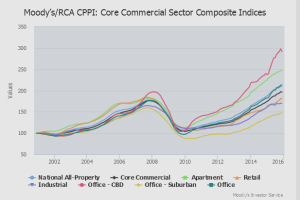After months of optimism, commercial real estate (CRE) forecasters have come back down to earth, with Morgan Stanley predicting no growth whatsoever in commercial property prices this year. The tonal shift is warranted: While rents and prices are soaring in urban areas, CRE is stagnating or even declining in terms of new investment and in most non-urban sectors. In many ways, the trends we’re seeing today are the culmination of nearly two decades of generationally driven migration patterns. Although Boomer youth eschewed cities in favor of rural living, Millennials want to live and work in urban areas—a shift that is triggering a highly focused boomlet that has left most of the rest of CRE untouched.
Over recent months, media outlets have touted CRE’s comeback. And for good reason: Overall prices have skyrocketed—up 93% from 2010’s low and 16% above 2007’s high. At the same time, investors are flooding the market. By the end of the first quarter of 2015, banks had $1.7 trillion of CRE loans outstanding—just 2.6% shy of the record set in the first quarter of 2009.
After months of optimism, commercial real estate (CRE) forecasters have come back down to earth, with Morgan Stanley predicting no growth whatsoever in commercial property prices this year. The tonal shift is warranted: While rents and prices are soaring in urban areas, CRE is stagnating or even declining in terms of new investment and in most non-urban sectors. In many ways, the trends we’re seeing today are the culmination of nearly two decades of generationally driven migration patterns. Although Boomer youth eschewed cities in favor of rural living, Millennials want to live and work in urban areas—a shift that is triggering a highly focused boomlet that has left most of the rest of CRE untouched.
Over recent months, media outlets have touted CRE’s comeback. And for good reason: Overall prices have skyrocketed—up 93% from 2010’s low and 16% above 2007’s high. At the same time, investors are flooding the market. By the end of the first quarter of 2015, banks had $1.7 trillion of CRE loans outstanding—just 2.6% shy of the record set in the first quarter of 2009.
Read entire article at Forbes Online here http://www.forbes.com/sites/neilhowe/2016/02/24/has-the-bubble-burst-in-commercial-real-estate/#29095cc555c7




